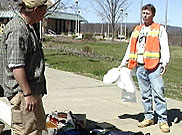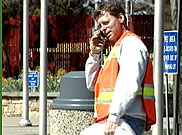Current Screen: 23 of 27
Safely Observe
Your fourth responsibility in transportation security is to safely observe suspicious activity. Remember that in the neighborhood watch concept you are to observe and report. Your efforts only enhance, they do not replace traditional security practices. Your personal safety is the top priority.
DO NOT:
The purpose of observation is to make a judgement as to whether or not suspicion is warranted and if it is, to collect useful and accurate information to report.
Only if you feel comfortable and do not feel threatened, you may approach and engage a suspicious person using the following six steps to confirm or resolve your suspicions:
Step 1: Observation: Be alert to the person's behavior and accessories. Is the person wearing or carrying bulky objects? Do you see wires running down shirt sleeves, along the belt, to an ear, or anywhere on the body? Do you see small weapons or objects in the hands? Is the person sweating profusely or acting nervous? Is the person interacting with other people who may be accomplices?
Step 2: Presence: Use body language to communicate confidence. Maintain a solid, upright posture with your weight equally distributed on both feet. Keep your hands comfortably at your sides, unless using them to make deliberate, purposeful but non-threatening gestures. Maintain direct, but comfortable eye contact and use a clear, even tone of voice.
Step 3: Greeting Initiate contact in a friendly, non-threatening manner. Examples:
"Good morning/good afternoon" or "How are you doing?" or "How can I help you?".


Step 4: Dialogue Use conversation to get information or an explanation about the suspicious person's activity or behavior. Do not offer information or provide answers in your conversation. Example: Are you here to see John Smith? Do not use questions that can be answered with yes or no. Example: Are you here for the meeting? Do ask open-ended questions. Use words like: Who, What, Where, When, How, and Why. Example: Who are you here to see? Allow the person an opportunity to respond. Be direct and brief.
Step 5: Withdrawal After you have gathered the information, you need to withdraw. Thank the person for his or her time and cooperation. Offer to escort him or her from the restricted area. Break eye contact and move away. Review the information and organize it for a report.
Step 6: Notification Make notification if there is no explanation for the person's presence. Try to keep the person in sight at all times. Observe and report the person's location, activity, behavior, and physical characteristics. Check the areas where he or she was seen for signs of tampering or suspicious packages or substances.

